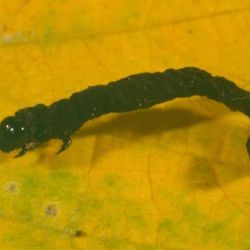Bt (Bacillus thuringiensis)

Looper larva killed by Bt
© H. Brier, Queensland Government
The spores of this naturally occurring bacteria contain a toxin that affects the larval stages of many moths. Different Bt strains can affect other insect groups such as mosquitoes.
Bt-derived toxins have been developed as organic biopesticides and Bt toxin expression in genetically modified crops has led to a significant reduction in insecticide use.
Scientific name
Description
When infected with Bt, larvae will shrivel and turn black.
Distribution and habitat
Larvae must ingest the toxin to be affected. Unlike viral infections such as NPV, Bt does not spread between individuals in the larval population.
Hosts
Helicoverpa, loopers, Spodoptera and other caterpillars.
Impact on pests
Larvae cease feeding within several hours of ingesting Bt. The toxin affects the gut wall and larvae die within 3–4 days from a combination of infection and starvation.
The toxin is highly specific. Commercial formulations of Bt are non-toxic to humans and other mammals, bees, fish and other wildlife.
Factors that influence effectiveness
Bt tends to be more effective on smaller larvae (i.e. 1st to 3rd instar).
Bt as a biopesticide:
- requires good coverage to maximise ingestion
- degrades with exposure to sunlight
- can be washed off by rainfall or overhead irrigation
- is often mixed with additives such as surfactants or feeding attractants to increase efficacy.
Further information
Current pesticide registrations—Australian Pesticides and Veterinary Medicines Authority (APVMA)